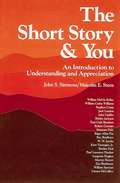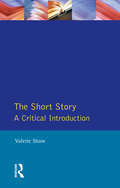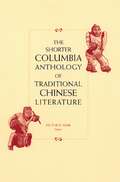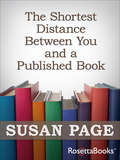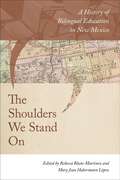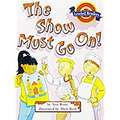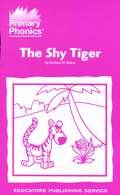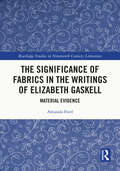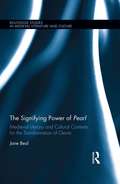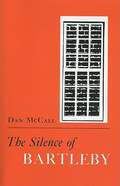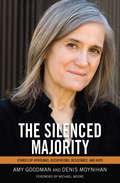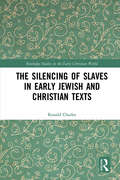- Table View
- List View
The Short Story and You: An Introduction to Understanding and Appreciation
by John S. Simmons Malcolm E. SternDiscusses the short story as a literary form and presents selections by such authors as Edgar Allan Poe, Robert Cormier, Kurt Vonnegut, and John Updike. Discussion questions follow each story.
The Short Story and the First World War
by Ann-Marie EinhausThe poetry of the First World War has come to dominate our understanding of its literature, while genres such as the short story, which are just as vital to the literary heritage of the era, have largely been neglected. In this study, Ann-Marie Einhaus challenges deeply embedded cultural conceptions about the literature of the First World War using a corpus of several hundred short stories that, until now, have not undergone any systematic critical analysis. From early wartime stories to late twentieth-century narratives - and spanning a wide spectrum of literary styles and movements - Einhaus's work reveals a range of responses to the war through fiction, from pacifism to militarism. Going beyond the household names of Owen, Sassoon, and Graves, Einhaus offers scholars and students unprecedented access to new frontiers in twentieth-century literary studies.
The Short Story in Midcentury America: Countercultural Form in the Work of Bowles, McCarthy, Welty, and Williams
by Sam V. ReeseThe Short Story in Midcentury America provides in-depth case studies of four major writers of the post–World War II era—Paul Bowles, Mary McCarthy, Eudora Welty, and Tennessee Williams—examining how they used the contained aesthetics of short fiction to map out an oppositional stance to the dominant narratives, both political and literary, of mid-twentieth century U.S. culture.Sam V. H. Reese presents a new understanding of the connections between politics, ideology, and literary form, arguing that writers employed the short story to critique the cultural mores of the early Cold War. The four authors under discussion found themselves socially marginalized by mainstream U.S. culture due to such factors as their gender, sexual orientation, religion, and foreign residence. Reese shows that each author embraced the short story’s compressed form as a means of resisting political coercion and conformity, speaking out in support of freedom and open expression.Reese argues that these four writers used the formal restrictions of the short story to develop a type of fiction that became recognizably countercultural, challenging the expansive, sprawling novels then receiving acclaim from critics. His analysis underscores the means by which each author’s short stories utilized the aesthetic practices of mediums outside conventional narrative fiction: Bowles’s career as a composer, McCarthy’s criticism and memoirs, Williams’s playwriting, and Welty’s photography. By studying both their prose and its conceptualization, Reese reveals how writers resisted the political and stylistic pressures that defined U.S. literary culture in the early years of the Cold War.In The Short Story in Midcentury America, Reese establishes a new framework for considering countercultural literature in the United States, reassessing the critical standing of the short story and re-evaluating the relationship between marginal social positions and literary form during the mid-twentieth century.
The Short Story in South Africa: Contemporary Trends and Perspectives (Routledge Contemporary South Africa)
by Rebecca Fasselt Corinne SandwithThis book considers the key critical interventions on short story writing in South Africa written in English since the year 2000. The short story genre, whilst often marginalised in national literary canons, has been central to the trajectory of literary history in South Africa. In recent years, the short story has undergone a significant renaissance, with new collections and young writers making a significant impact on the contemporary literary scene, and subgenres such as speculative fiction, erotic fiction, flash fiction and queer fiction expanding rapidly in popularity. This book examines the role of the short story genre in reflecting or championing new developments in South African writing and the ways in which traditional boundaries and definitions of the short story in South Africa have been reimagined in the present. Drawing together a range of critical interventions, including scholarly articles, interviews and personal reflective pieces, the volume traces some of the aesthetic and thematic continuities and discontinuities in the genre and sheds new light on questions of literary form. Finally, the book considers the place of the short story in twenty-first century writing and interrogates the ways in which the short story form may contribute to, or recast ideas of, the post-apartheid or post-transitional. The perfect guide to contemporary short story writing in South Africa, this book will be essential reading for researchers of African literature.
The Short Story of the Novel: A Pocket Guide to Key Genres, Novels, Themes and Techniques
by Henry RussellA fascinating and innovative introduction to the best works of fiction from the last 500 years. Simply constructed, the book explores 60 key novels from The Tale of Genji to My Brilliant Friend.In addition to enjoyable descriptions of the novels and concise explanations of why they are important, the book illuminates the most significant writing genres, themes and techniques.Accessible and fun to read, with a foreword by Professor Peter Boxall, this pocket guide will give readers a new way to enjoy their favourite books - and to discover new ones.
The Short Story of the Novel: A Pocket Guide to Key Genres, Novels, Themes and Techniques
by Henry RussellA fascinating and innovative introduction to the best works of fiction from the last 500 years. Simply constructed, the book explores 60 key novels from The Tale of Genji to My Brilliant Friend.In addition to enjoyable descriptions of the novels and concise explanations of why they are important, the book illuminates the most significant writing genres, themes and techniques.Accessible and fun to read, with a foreword by Professor Peter Boxall, this pocket guide will give readers a new way to enjoy their favourite books - and to discover new ones.
The Short Story: A Critical Introduction
by Valerie ShawThroughout this text, Valerie Shaw addresses two key questions: 'What are the special satisfactions afforded by reading short stories?' and 'How are these satisfactions derived from each story's literary techniques and narrative strategies?'. She then attempts to answer these questions by drawing on stories from different periods and countries - by authors who were also great novelists, like Henry James, Flaubert, Kafka and D.H. Lawrence; by authors who specifically dedicated themselves to the art of the short story, like Kipling, Chekhov and Katherine Mansfield; by contemporary practitioners like Angela Carter and Jorge Luis Borges; and by unfairly neglected writers like Sarah Orne Jewett and Joel Chandler Harris.
The Short Story: The Reality of Artifice (Genres in Context)
by Charles MayThe short story is one of the most difficult types of prose to write and one of the most pleasurable to read. From Boccaccio's Decameron to The Collected Stories of Reynolds Price, Charles May gives us an understanding of the history and structure of this demanding form of fiction. Beginning with a general history of the genre, he moves on to focus on the nineteenth-century when the modern short story began to come into focus. From there he moves on to later nineteenth-century realism and early twentieth-century formalism and finally to the modern renaissance of the form that shows no signs of abating. A chronology of significant events, works and figures from the genre's history, notes and references and an extensive bibliographic essay with recommended reading round out the volume.
The Short and Long of It
by Paul Alan FaheyDo you write short fiction but long to s-t-r-e-t-c-h those tight little 55ers, flash pieces, and short stories into longer, publishable work? Do you have binders full of short pieces with characters you’d love to flesh out? Are you dying to tell the rest of these stories?If so,The Short and Long of Itis for you!Award-winning short fiction writer Paul Alan Fahey shows you how to expand and adapt your brief creations into longer, more satisfying stories, plays, novellas, and novels pitch perfect for publication in the e-age.This book will help you practice expanding your short fiction. Through detailed examples and hands-on exercises, you’ll learn how to:Adapt 55 fiction into flash fiction;Adapt flash fiction into short stories and plays;Adapt flash memoir into personal essays;Write a tight logline;Develop a story theme;Build three-act structure; andDevelop characters and enhance backstory.So grab a copy today and start writing longer stories tomorrow!
The Shortcut: Why Intelligent Machines Do Not Think Like Us
by Nello CristianiniAn influential scientist in the field of artificial intelligence (AI) explains its fundamental concepts and how it is changing culture and society.A particular form of AI is now embedded in our tech, our infrastructure, and our lives. How did it get there? Where and why should we be concerned? And what should we do now? The Shortcut: Why Intelligent Machines Do Not Think Like Us provides an accessible yet probing exposure of AI in its prevalent form today, proposing a new narrative to connect and make sense of events that have happened in the recent tumultuous past, and enabling us to think soberly about the road ahead.This book is divided into ten carefully crafted and easily digestible chapters. Each chapter grapples with an important question for AI. Ranging from the scientific concepts that underpin the technology to wider implications for society, it develops a unified description using tools from different disciplines and avoiding unnecessary abstractions or words that end with -ism. The book uses real examples wherever possible, introducing the reader to the people who have created some of these technologies and to ideas shaping modern society that originate from the technical side of AI. It contains important practical advice about how we should approach AI in the future without promoting exaggerated hypes or fears.Entertaining and disturbing but always thoughtful, The Shortcut confronts the hidden logic of AI while preserving a space for human dignity. It is essential reading for anyone with an interest in AI, the history of technology, and the history of ideas. General readers will come away much more informed about how AI really works today and what we should do next.
The Shorter Columbia Anthology of Traditional Chinese Literature (Translations from the Asian Classics)
by Victor MairWith its fresh translations by newer voices in the field, its broad scope, and its flowing style, this anthology places the immense riches of Chinese literature within easy reach. Ranging from the beginnings to 1919, this abridged version of The Columbia Anthology of Traditional Chinese Literature retains all the characteristics of the original. In putting together these selections Victor H. Mair interprets "literature" very broadly to include not just literary fiction, poetry, and drama, but folk and popular literature, lyrics and arias, elegies and rhapsodies, biographies, autobiographies and memoirs, letters, criticism and theory, and travelogues and jokes.
The Shorter Writings: "apology Of Socrates To The Jury," "oeconomicus," And "symposium" (Agora Editions)
by XenophonThis book contains new, annotated, and literal yet accessible translations of Xenophon’s eight shorter writings, accompanied by interpretive essays that reveal these works to be masterful achievements by a serious thinker of the first rank who raises important moral, political, and philosophical questions. Five of these shorter writings are unmistakably devoted to political matters. The Agesilaos is a eulogy of a Spartan king, and the Hiero, or the Skilled Tyrant recounts a searching dialogue between a poet and a tyrant. The Regime of the Lacedaemonians presents itself as a laudatory examination of what turns out to be an oligarchic regime of a certain type, while The Regime of the Athenians offers an unflattering picture of a democratic regime. Ways and Means, or On Revenues offers suggestions on how to improve the political economy of Athens’ troubled democracy.The other three works included here—The Skilled Cavalry Commander, On Horsemanship, and The One Skilled at Hunting with Dogs—treat skills deemed appropriate for soldiers and leaders, touching on matters of political importance, especially in regard to war. By bringing together Xenophon’s shorter writings, this volume aims to help those interested in Xenophon to better understand the core of his thought, political as well as philosophical.Interpretive essays by: Wayne Ambler, Robert C. Bartlett, Amy L. Bonnette, Susan D. Collins, Michael Ehrmantraut, David Levy, Gregory A. McBrayer, Abram N. Shulsky.
The Shortest Distance Between You and a Published Book
by Susan Page&“The most thorough, accurate, user-friendly, well-organized and inspiring guide for writers on the market today. Period.&”—Richard Carlson, #1 New York Times bestselling author of Don&’t Sweat the Small Stuff This expert guide has put the dream of acquiring a publisher within reach for thousands of writers. Whether your book idea is a completed manuscript or still in the planning stages, The Shortest Distance Between You and a Published Book offers comprehensive, industry-savvy guidance on the steps to take to sell your book to a major publisher. Literary agents often advise their clients to read this book as their first step. Susan Page is the author of several bestselling self-help books, and a veteran of the publishing industry. Here, she&’ll guide you step-by-step through the roadblocks that stall other writers and help you toward a publishing strategy that gets results. You&’ll find in-depth information on the early steps to take, writing title ideas, developing winning book proposals, finding an agent, understanding publishing contracts, promoting your book, and more. Throughout the process, Page coaches you through both the emotional and practical obstacles you&’re likely to face. It&’s a must-read for anyone interested in a career as a published author. &“Page, as her subtitle claims, really does tell you what you need to know to get happily published. This self-help author (If I&’m So Wonderful, Why Am I Still Single?) knows what she&’s talking about, whether she&’s advising on how to write a book proposal, find an agent or promote one&’s book . . . This is one of the more instructive guides to read before writing your book.&”—Publishers Weekly
The Shoulders We Stand On: A History of Bilingual Education in New Mexico
by Rebecca Blum Martinez and Mary Jean Habermann LópezThe Shoulders We Stand On traces the complex history of bilingual education in New Mexico, covering Spanish, Diné, and Pueblo languages. The book focuses on the formal establishment of bilingual education infrastructure and looks at the range of contemporary challenges facing the educational environment today. The book&’s contributors highlight particular actions, initiatives, and people that have made significant impacts on bilingual education in New Mexico, and they place New Mexico&’s experience in context with other states&’ responses to bilingual education. The book also includes an excellent timeline of bilingual education in the state. The Shoulders We Stand On is the first book to delve into the history of bilingual education in New Mexico and to present New Mexico&’s leaders, families, and educators who have pioneered program development, legislation, policy, evaluation, curriculum development, and teacher preparation in the field of bilingual multicultural education at state and national levels. Historians of education, educators, and educators in training will want to consider this as required reading.
The Sides of the Sea: Caribbean Women Writing Diaspora (Caribbean Studies Series)
by Johanna X. GarveyIn The Sides of the Sea: Caribbean Women Writing Diaspora, Johanna X. K. Garvey examines the works of contemporary writers from eight Caribbean countries, including Haiti, Trinidad and Tobago, and the Dominican Republic. Authors from Anglophone, Francophone, and Spanish-speaking countries illustrate experiences across the African Diaspora, including enslavement, colonialism, revolt, marronage, and decolonization. Characters in fiction and poetry by such writers as Erna Brodber, Jan J. Dominique, Mayra Santos-Febres, Tessa McWatt, and Dionne Brand confront trauma, engage in struggle, forge connection, and act as agents of change. Complicating categories of identification and employing multiple strategies of resistance, these Caribbean women writers show us paths out of and beyond the binaries embedded in colonialism and its aftermath. As their texts remember moments and sites of trauma beginning with the Middle Passage, they embark on new passages, claim oceanic spaces, and suggest directions that stretch beyond the Black Atlantic to a more complex understanding of how to “pull the sides of the sea together” in the twenty-first century. The Sides of the Sea is organized in three sections: “Plumbing the Depths,” which examines representations of the Middle Passage and its legacies; “Voicing the Wounds,” which explores genealogies, inherited trauma, and potential healing; “Unsettling Borders,” which discusses decolonial epistemologies, transgressive sexualities, and new visions of citizenship.
The Significance of Fabrics in the Writings of Elizabeth Gaskell: Material Evidence (Routledge Studies in Nineteenth Century Literature)
by Amanda FordElizabeth Gaskell’s writings abound in references to a cultural materiality encompassing different types of fabric, stuffs, calicoes, chintzes and fine-point lace. These are not merely the motifs of the Realist genre but reveal a complex polysemy. Utilizing a metonymic examination of these tropes, this volume exposes the dramatic structural and socio-economic upheaval generated by industrialization, urbanization and the widening sphere of empire. The material evidence testifies to the technological and production innovations evolving diachronically for the period, and the evolution of Manchester as the industrial ‘Cottonpolis’ that clothed the world by the 1840s. This volume analyses Gaskell’s manipulation of the materiality, arguing its firm roots in the quotidian of women’s domestic and provincial life within the growing ranks of the middle classes. Exploring Gaskell’s tactile imagination, an embodied relationship with fabrics and sewing, a function of her daily life from an early age, this volume provides insight into the sensory aspects of cloth and its ability to stir affective responses, emotions and memories, whereby worn fabrics and even the absence of previous textile treasures, is poignant, recreating layers of recollection. This book aims to restore the pulsating, dynamic context of ordinary women’s dressed lives and presents innovative interpretations of Gaskell’s texts.
The Signifying Monkey: A Theory of African American Literary Criticism
by Henry Louis GatesThis book is a groundbreaking work that illuminates the relationship between the African and African-American vernacular traditions and black literature. It elaborates a new critical approach located within this tradition that allows the black voice to speak for itself. Examining the ancient poetry and myths found in African, Latin American, and Caribbean culture, the author uncovers a unique system for interpretation and a powerful vernacular tradition that black slaves brought with them to the New World. Exploring the process of signification in black American life and literature by analyzing the transmission and revision of various signifying figures, He provides an extended analysis of what he calls the "Talking Book," a central trope in early slave narratives that virtually defines the tradition of black American letters. He uses this critical framework to examine several major works of African-American literature and revealing how these works signify on the black tradition and on each other. This superb 25th-Anniversary Edition features a new preface by the author that reflects on the impact of the book and its relevance for today's society as well as a new afterword written by noted critic W. T. J. Mitchell.
The Signifying Power of Pearl: Medieval Literary and Cultural Contexts for the Transformation of Genre
by Jane BealThis book enhances our understanding of the exquisitely beautiful, fourteenth-century, Middle English dream vision poem Pearl. Situating the study in the contexts of medieval literary criticism and contemporary genre theory, Beal argues that the poet intended Pearl to be read at four levels of meaning and in four corresponding genres: literally, an elegy; spiritually, an allegory; morally, a consolation; and anagogically, a revelation. The book addresses cruxes and scholarly debates about the poem’s genre and meaning, including key questions that have been unresolved in Pearl studies for over a century: * What is the nature of the relationship between the Dreamer and the Maiden? * What is the significance of allusions to Ovidian love stories and the use of liturgical time in the poem? * How does avian symbolism, like that of the central symbol of the pearl, develop, transform, and add meaning throughout the dream vision? * What is the nature of God portrayed in the poem, and how does the portrayal of the Maiden’s intimate relationship to God, her spiritual marriage to the Lamb, connect to the poet’s purpose in writing? Noting that the poem is open to many interpretations, Beal also considers folktale genre patterns in Pearl, including those drawn from parable, fable, and fairy-tale. The conclusion considers Pearl in the light of modern psychological theories of grieving and trauma. This book makes a compelling case for re-reading Pearl and recognizing the poem’s signifying power. Given the ongoing possibility of new interpretations, it will appeal to those who specialize in Pearl as well as scholars of Middle English, Medieval Literature, Genre Theory, and Literature and Religion.
The Silence of Bartleby
by Dan MccallIn this work of criticism, Dan McCall proposes a new reading of Herman Melville's classic short tale "Bartleby, The Scrivener."
The Silence of the Miskito Prince: How Cultural Dialogue Was Colonized
by Matt CohenConfronting the rifts created by our common conceptual vocabulary for North American colonial studies How can we tell colonial histories in ways that invite intercultural conversation within humanistic fields that are themselves products of colonial domination? Beginning with a famous episode of failed communication from the narrative of the freed slave Olaudah Equiano, The Silence of the Miskito Prince explores this question by looking critically at five concepts frequently used to imagine solutions to the challenges of cross-cultural communication: understanding, cosmopolitanism, piety, reciprocity, and patience. Focusing on the first two centuries of North American colonization, Matt Cohen traces how these five concepts of cross-cultural relations emerged from, and continue to evolve within, colonial dynamics. Through a series of revealing archival explorations, he argues the need for a new vocabulary for the analysis of past interactions drawn from the intellectual and spiritual domains of the colonized, and for a historiographical practice oriented less toward the illusion of complete understanding and scholarly authority and more toward the beliefs and experiences of descendant communities. The Silence of the Miskito Prince argues for new ways of framing scholarly conversations that use past interactions as a site for thinking about intercultural relations today. By investigating the colonial histories of these terms that were assumed to promote inclusion, Cohen offers both a reflection on how we got here and a model of scholarly humility that holds us to our better or worse pasts.
The Silenced Majority: Stories of Uprisings, Occupations, Resistance, and Hope
by Amy Goodman Denis MoynihanThe New York Times–bestselling collection of essays on the power of ordinary people to effect lasting change—from the host and cofounder of Democracy Now! Amy Goodman and Denis Moynihan began writing a weekly column, &“Breaking the Sound Barrier,&” for King Features Syndicate in 2006. This timely new sequel to Goodman&’s New York Times bestseller of the same name gives voice to the many ordinary people standing up to corporate and government power—and refusing to be silent. The Silenced Majority pulls back the veil of corporate media reporting to dig deep into the politics of &“climate apartheid,&” the implications of the Fukushima nuclear disaster, the movement to halt the execution of Troy Anthony Davis, and the globalization of dissent &“from Tahrir Square to Liberty Plaza.&” Throughout, Goodman and Moynihan show the work of ordinary people to change their media—and change the world. Praise for Amy Goodman &“Amy Goodman has taken investigative journalism to new heights.&” —Noam Chomsky, leading public intellectual and author of Hopes and Prospects &“Amy Goodman is not afraid to speak truth to power. She does it every day.&” —Susan Sarandon, activist and actress &“Crusading journalism at its best.&” —Arianna Huffington, founder of The Huffington Post &“A towering progressive freedom fighter in the media and the world.&” —Cornel West, author of Race Matters &“What journalism should be: beholden to the interests of people, not power and profit.&” —Arundhati Roy, author of The End of Imagination
The Silencing of Slaves in Early Jewish and Christian Texts (Routledge Studies in the Early Christian World)
by Ronald CharlesThe Silencing of Slaves in Early Jewish and Christian Texts analyzes a large corpus of early Christian texts and Pseudepigraphic materials to understand how the authors of these texts used, abused and silenced enslaved characters to articulate their own social, political, and theological visions. The focus is on excavating the texts "from below" or "against the grain" in order to notice the slaves, and in so doing, to problematize and (re)imagine the narratives. Noticing the slaves as literary iterations means paying attention to broader theological, ideological, and rhetorical aims of the texts within which enslaved bodies are constructed. The analysis demonstrates that by silencing slaves and using a rhetoric of violence, the authors of these texts contributed to the construction of myths in which slaves functioned as a useful trope to support the combined power of religion and empire. Thus was created not only the perfect template for the rise and development of a Christian discourse of slavery, but also a rationale for subsequent violence exercised against slave bodies within the Christian Empire. The study demonstrates the value of using the tools and applying the insights of subaltern studies to the study of the Pseudepigrapha and in early Christian texts. This volume will be of interest not only to scholars of early Christianity, but also to those working on the history of slavery and subaltern studies in antiquity.
The Silicone Breast Implant Story: Communication and Uncertainty (Routledge Communication Series)
by David H. Smith Marsha L. VanderfordThis volume examines one health issue -- breast implants -- across a series of contexts often thought to be separate -- media coverage, doctor-patient interaction, doctor-doctor professional communication, support group dialogues, public relations campaigns, and more. In so doing, it provides a narrative of how communication shapes the individual perceptions of health, government, and social policy concerning health care. At the core of the silicone breast implant controversy is the need for people to act amid uncertainty about the health risks involved. This need to weigh action in the midst of uncertain risk characterizes a large number of health issues. The attempts of patients, physicians, drug manufacturers, and others to seek and provide both information and influence makes communication central to these issues. Consequently, the questions explored in this volume will interest a diverse group of readers. This audience includes plastic surgeons in particular, physicians in general, and anyone involved with women's health issues. As the medical profession struggles with its identity amid changes in public attitudes, government regulations, and medical practices, this volume's findings concerning media portrayals of doctors and medical devices become even more important. Finally, this study reveals how interrelated public information and private decisions are, and how closely media and interpersonal relationships fit. Tracing one medical issue across interpersonal, organizational, public relations, and mediated forums has clearly demonstrated the multiple ways those communication channels overlap and inform one another.
